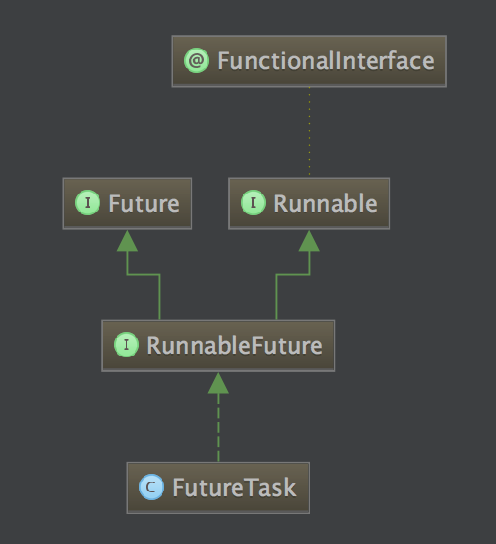一、概述
FutureTask包装器是一种非常便利的机制,同时实现了Future和Runnable接口。
类图如下:

FutureTask是一种可以取消的异步的计算任务。它的计算是通过Callable实现的,它等价于可以携带结果的Runnable,并且有三个状态:等待、运行和完成。完成包括所有计算以任意的方式结束,包括正常结束、取消和异常。
Future有个get方法而获取结果只有在计算完成时获取,否则会一直阻塞直到任务转入完成状态,然后会返回结果或者抛出异常。
FutureTask有下面几个重要的方法:
1.get()
阻塞一直等待执行完成拿到结果
2.get(int timeout, TimeUnit timeUnit)
阻塞一直等待执行完成拿到结果,如果在超时时间内,没有拿到抛出异常
3.isCancelled()
是否被取消
4.isDone()
是否已经完成
5.cancel(boolean mayInterruptIfRunning)
试图取消正在执行的任务
二、FutureTask的状态转换过程
* NEW -> COMPLETING -> NORMAL * NEW -> COMPLETING -> EXCEPTIONAL * NEW -> CANCELLED * NEW -> INTERRUPTING -> INTERRUPTED
三、FutureTask的执行过程
创建一个futureTask对象task 提交task到调度器executor等待调度或者在另外一个线程中执行task 等待调度中... 如果此时currentThread调取执行结果task.get(),会有几种情况 if task 还没有被executor调度或正在执行中 阻塞当前线程,并加入到一个阻塞链表中waitNode else if task被其它Thread取消,并取消成功 或task处于中断状态 throw exception else if task执行完毕,返回执行结果,或执行存在异常,返回异常信息 如果此时有另外一个线程调用task.get() 执行过程同上
四、应用场景
1. Future用于异步获取执行结果或者取消任务。
2. 在高并发场景下确保任务只执行一次。
五、源码分析
1.核心状态
1 /** 2 * The run state of this task, initially NEW. The run state 3 * transitions to a terminal state only in methods set, 4 * setException, and cancel. During completion, state may take on 5 * transient values of COMPLETING (while outcome is being set) or 6 * INTERRUPTING (only while interrupting the runner to satisfy a 7 * cancel(true)). Transitions from these intermediate to final 8 * states use cheaper ordered/lazy writes because values are unique 9 * and cannot be further modified. 10 * 11 * Possible state transitions: 12 * NEW -> COMPLETING -> NORMAL 13 * NEW -> COMPLETING -> EXCEPTIONAL 14 * NEW -> CANCELLED 15 * NEW -> INTERRUPTING -> INTERRUPTED 16 */ 17 private volatile int state; 18 private static final int NEW = 0; 19 private static final int COMPLETING = 1; 20 private static final int NORMAL = 2; 21 private static final int EXCEPTIONAL = 3; 22 private static final int CANCELLED = 4; 23 private static final int INTERRUPTING = 5; 24 private static final int INTERRUPTED = 6;
2.构造函数
1 public FutureTask(Callable<V> callable) { 2 if (callable == null) 3 throw new NullPointerException(); 4 this.callable = callable; 5 this.state = NEW; // ensure visibility of callable 6 } 7 8 public FutureTask(Runnable runnable, V result) { 9 this.callable = Executors.callable(runnable, result); 10 this.state = NEW; // ensure visibility of callable 11 }
3.获取执行结果
1 public V get() throws InterruptedException, ExecutionException { 2 int s = state; 3 if (s <= COMPLETING) 4 s = awaitDone(false, 0L); 5 return report(s); 6 } 7 8 public V get(long timeout, TimeUnit unit) 9 throws InterruptedException, ExecutionException, TimeoutException { 10 if (unit == null) 11 throw new NullPointerException(); 12 int s = state; 13 if (s <= COMPLETING && 14 (s = awaitDone(true, unit.toNanos(timeout))) <= COMPLETING) 15 throw new TimeoutException(); 16 return report(s); 17 }
4.执行方法
1 public void run() { 2 if (state != NEW || 3 !UNSAFE.compareAndSwapObject(this, runnerOffset, 4 null, Thread.currentThread())) 5 return; 6 try { 7 Callable<V> c = callable; 8 if (c != null && state == NEW) { 9 V result; 10 boolean ran; 11 try { 12 result = c.call(); 13 ran = true; 14 } catch (Throwable ex) { 15 result = null; 16 ran = false; 17 setException(ex); 18 } 19 if (ran) 20 set(result); 21 } 22 } finally { 23 // runner must be non-null until state is settled to 24 // prevent concurrent calls to run() 25 runner = null; 26 // state must be re-read after nulling runner to prevent 27 // leaked interrupts 28 int s = state; 29 if (s >= INTERRUPTING) 30 handlePossibleCancellationInterrupt(s); 31 } 32 }
5.设置状态
1 protected void set(V v) { 2 if (UNSAFE.compareAndSwapInt(this, stateOffset, NEW, COMPLETING)) { 3 outcome = v; 4 UNSAFE.putOrderedInt(this, stateOffset, NORMAL); // final state 5 finishCompletion(); 6 } 7 } 8 9 protected void setException(Throwable t) { 10 if (UNSAFE.compareAndSwapInt(this, stateOffset, NEW, COMPLETING)) { 11 outcome = t; 12 UNSAFE.putOrderedInt(this, stateOffset, EXCEPTIONAL); // final state 13 finishCompletion(); 14 } 15 }
六、代码示例
1. FutureTask执行多任务计算的使用场景
利用FutureTask和ExecutorService,可以用多线程的方式提交计算任务,主线程继续执行其他任务,当主线程需要子线程的计算结果时,在异步获取子线程的执行结果。
1 public class FutureTaskForMultiCompute { 2 public static void main(String[] args) throws InterruptedException, ExecutionException { 3 // 创建任务集合 4 List<FutureTask<Integer>> taskList = new ArrayList<FutureTask<Integer>>(); 5 // 创建线程池 6 ExecutorService exec = Executors.newFixedThreadPool(5); 7 for (int i = 0; i < 10; i++) { 8 FutureTask<Integer> ft = new FutureTask<>(new ComputeTask(i, ""+i)); 9 taskList.add(ft); 10 // 提交给线程池执行任务,也可以通过exec.invokeAll(taskList)一次性提交所有任务; 11 exec.submit(ft); 12 } 13 14 System.out.println("所有计算任务提交完毕, 主线程接着干其他事情!"); 15 16 // 开始统计各计算线程计算结果 17 Integer totalResult = 0; 18 for (FutureTask<Integer> ft : taskList) { 19 totalResult += ft.get(); 20 } 21 22 // 关闭线程池 23 exec.shutdown(); 24 System.out.println("多任务计算后的总结果是:" + totalResult); 25 } 26 27 } 28 class ComputeTask implements Callable<Integer> { 29 30 private Integer result = 0; 31 private String taskName = ""; 32 33 public String getTaskName(){ 34 return this.taskName; 35 } 36 37 public ComputeTask(Integer iniResult, String taskName){ 38 result = iniResult; 39 this.taskName = taskName; 40 System.out.println("生成子线程计算任务: "+taskName); 41 } 42 43 @Override 44 public Integer call() throws Exception { 45 for (int i = 0; i < 100; i++) { 46 result =+ i; 47 } 48 // 休眠5秒钟,观察主线程行为,预期的结果是主线程会继续执行,到要取得FutureTask的结果是等待直至完成。 49 Thread.sleep(5000); 50 System.out.println("子线程计算任务: "+taskName+" 执行完成!"); 51 return result; 52 } 53 54 }
2. FutureTask在高并发环境下确保任务只执行一次
在很多高并发的环境下,往往我们只需要某些任务只执行一次。这种使用情景FutureTask的特性恰能胜任。举一个例子,假设有一个带key的连接池,当key存在时,即直接返回key对应的对象;当key不存在时,则创建连接。对于这样的应用场景,通常采用的方法为使用一个Map对象来存储key和连接池对应的对应关系,典型的代码如下面所示:
1 public class FutureTaskTest { 2 private Map<String, Connection> connectionPool = new HashMap<String, Connection>(); 3 private ReentrantLock lock = new ReentrantLock(); 4 5 public Connection getConnection(String key){ 6 try { 7 lock.lock(); 8 if(connectionPool.containsKey(key)){ 9 return connectionPool.get(key); 10 }else{ 11 //创建 Connection 12 Connection conn = createConnection(); 13 connectionPool.put(key, conn); 14 return conn; 15 } 16 } finally{ 17 lock.unlock(); 18 } 19 20 } 21 22 //创建Connection 23 private Connection createConnection(){ 24 return null; 25 } 26 27 }
在上面的例子中,我们通过加锁确保高并发环境下的线程安全,也确保了connection只创建一次,然而确牺牲了性能。改用ConcurrentHash的情况下,几乎可以避免加锁的操作,性能大大提高,但是在高并发的情况下有可能出现Connection被创建多次的现象。这时最需要解决的问题就是当key不存在时,创建Connection的动作能放在connectionPool之后执行,这正是FutureTask发挥作用的时机,基于ConcurrentHashMap和FutureTask的改造代码如下:
1 public class FutureTaskTest { 2 private ConcurrentHashMap<String,FutureTask<Connection>>connectionPool = new ConcurrentHashMap<String, FutureTask<Connection>>(); 3 4 public Connection getConnection(String key) throws Exception{ 5 FutureTask<Connection> connectionTask = connectionPool.get(key); 6 if(connectionTask!=null){ 7 return connectionTask.get(); 8 } 9 else{ 10 Callable<Connection> callable = new Callable<Connection>(){ 11 @Override 12 public Connection call() throws Exception { 13 // TODO Auto-generated method stub 14 return createConnection(); 15 } 16 }; 17 FutureTask<Connection> newTask = new FutureTask<Connection>(callable); 18 connectionTask = connectionPool.putIfAbsent(key, newTask); 19 if(connectionTask==null){ 20 connectionTask = newTask; 21 connectionTask.run(); 22 } 23 return connectionTask.get(); 24 } 25 } 26 27 //创建Connection 28 private Connection createConnection(){ 29 return null; 30 } 31 32 }
经过这样的改造,可以避免由于并发带来的多次创建连接及锁的出现。